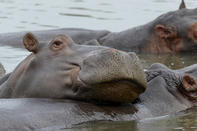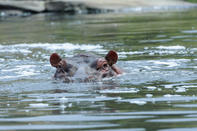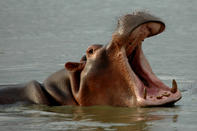Food and Exercise

Hippos save a great deal of energy by being in water. Their large barrel-like bodies are buoyed up by the water and consequently, hippos don’t need to eat as much as expected. An adult consumes only 15-40 kg of grass in a night, a mere 1.5% percent of its body weight.
Usually large mammals need to eat about 5% of their body weight to sustain their nutrient requirements. Hippos come out of the water at night to feed.
They leave the water in the late afternoon and split up to forage solitarily through the night. They follow well-used paths and generally don’t go further than 1-2 km from water, returning to it before the sun gets hot. During stressful conditions, hippos can travel 15 km in a night to find food.
Underwater Walk

Hippos walk on the bottom of rivers or dams and do not swim per se. They can create negative buoyancy by breathing out before submerging and this allows them to walk underwater.
They will also push themselves off the bottom with their feet and do a kind of ballet-gallop through the water. As they move, hippos create pathways through underwater vegetation, which is a valuable ecological service and is necessary to keep waterways flowing.
Hippos must surface in order to breathe. Hippos can remain submerged for 5-6 minutes. They are able to close their nostrils and ears to prevent water from getting inside them. Young, two-month-old, hippo can hold their breath for only about 40 seconds.
Water Safety

Hippos take to the water immediately if threatened. They use well-worn pathways to and from the water and if disturbed will charge headlong down these pathways to return to the safety of the water. In this way, many humans that have come between a hippo and the water have lost their lives.
There is a myth that hippos stamp out fires but this probably stems from fleeing hippos running through fires made at camps set up beside the river, in an effort to get back to the water.
Hippos are clumsy on land can’t jump or navigate over obstacles. They are however able to reach speeds of 36 kmph if provoked.
Natural Sunscreen

Hippos have unique skin. The fine epidermis renders the skin extremely sensitive to dehydration, up to seven times that of other mammals. For this reason, they while away the hottest hours of the day submerged in water without which, they would overheat.
If exposed to excessive heat and radiation the hippo will react firstly by secreting a red fluid from mucous glands on the skin, which is not blood, that acts as a sunscreen and thereafter the skin will dry and crack.
In times of drought, hippos pack together in mud pools to remain hydrated. This leads to a great deal of conflict and they may then travel vast distances seeking permanent water. Females have been observed dribbling saliva over exposed calves.
A hippo’s eyes, nostrils and ears are situated high on its head and this enables the hippo to keep its heat-sensitive body submerged while all its vital senses are above the water to keep a lookout for trouble.
Hippos bask in the sun to warm themselves up, particularly during cooler times of the year. Hippo calves lose heat much quicker than the adults. If it is cold, a calf will lift itself onto its mother’s back to bask in the sun.
By Megan Emmett